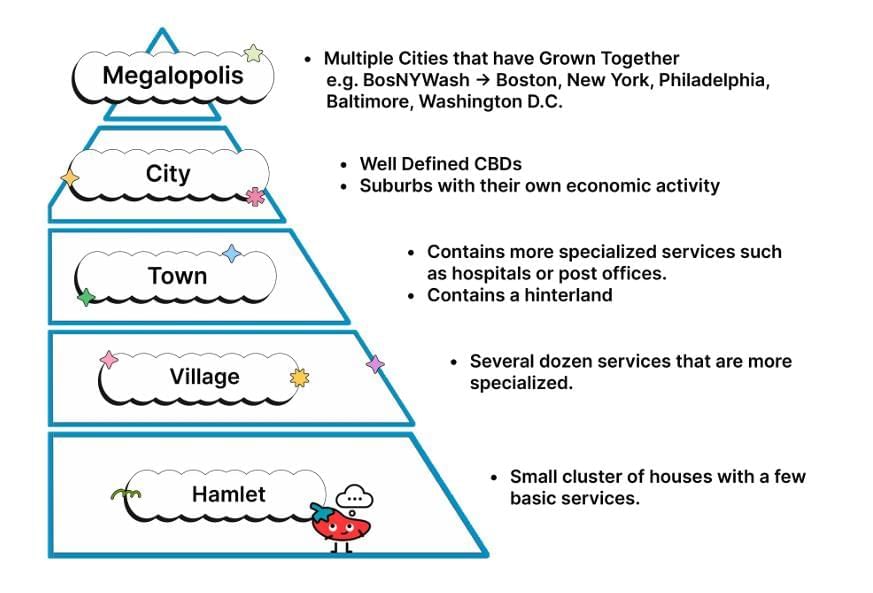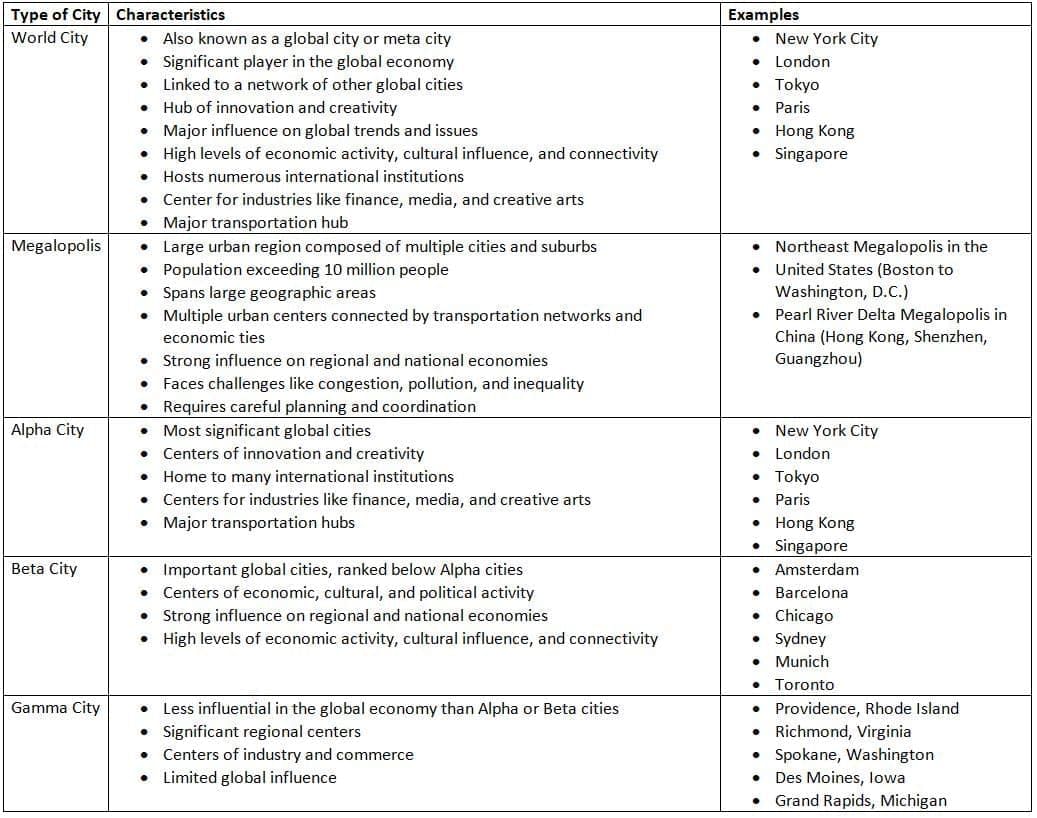Grade 9 Exam > Grade 9 Notes > AP Human Geography > Chapter Notes: Cities and Globalization
Cities and Globalization Chapter Notes | AP Human Geography - Grade 9 PDF Download
Introduction
This chapter notes explores the concept of cities through Louis Wirth’s sociological lens, emphasizing their size, density, and diversity. It examines the roles of cities of varying sizes in global and regional contexts, including mega cities, metropolises, and smaller urban centers. The chapter also delves into the urban hierarchy, classifying cities by their economic and cultural significance, and introduces key terms to understand urban dynamics.
Cities
- Louis Wirth, an American sociologist, described a city as a permanent settlement characterized by substantial size, high population density, and a diverse population in terms of social, economic, racial, and cultural backgrounds. Wirth’s definition hinges on three key traits that differentiate cities from rural areas: large size, elevated population density, and social stratification combined with heterogeneity.
- Wirth argued that the large size and dense populations of cities foster a sense of anonymity and impersonality among inhabitants, while their social stratification and diversity contribute to a rich and complex urban environment. These traits, according to Wirth, have significant social and psychological impacts on city residents.
- Examples of cities that align with Wirth’s characteristics include:
- New York City
- London
- Tokyo
- Hong Kong
- Singapore
- Wirth’s definition has profoundly influenced sociology, shaping how academics and policymakers view the essence and roles of cities. However, it has faced critique and refinement from later scholars who argue that it reflects a narrow, Western perspective and fails to fully capture the intricate and varied nature of urban life in non-Western contexts.
Importance Of Cities in Different Sizes
- Cities of varying sizes play critical roles in regional, national, and global economies and societies.
- Mega cities, defined as urban areas with populations exceeding 10 million, are often key economic, political, and cultural hubs, serving as centers of innovation and creativity. They drive economic growth and development, offering a broad array of amenities and services to residents. However, mega cities also confront challenges such as pollution, inequality, and the adverse effects of globalization.
- Large cities, with populations over 1 million, also serve as significant economic, political, and cultural centers, providing extensive amenities and services. These cities are hubs of innovation and creativity, playing pivotal roles in regional and national economies.
- Small cities, with populations under 1 million, contribute meaningfully to regional and national economies and offer residents a high quality of life. They can be centers of innovation and creativity, providing amenities such as healthcare, education, and cultural activities.
- Regardless of size, cities are vital hubs of economic, social, and cultural activity, delivering numerous benefits to their residents and the broader regions or countries they serve.

- The urban hierarchy classifies cities based on their size and significance. At the base of this hierarchy are the smallest settlements, such as hamlets and villages, which are typically rural with small populations. Above these are towns, which are larger than hamlets and villages, often featuring more developed infrastructure and larger populations. Cities, higher in the hierarchy, are significantly larger and more developed, with populations of at least 100,000 and a diverse range of industries and occupations.
- A metropolis is a major city or urban area that serves as the economic, cultural, and political hub of a region. A megalopolis is an even larger urban region, typically encompassing multiple cities and their suburbs that have merged into a continuous urban area. For example, New York City is a megalopolis, comprising five boroughs with a metropolitan area population exceeding 18 million people.

- New York City, London, and Tokyo are widely regarded as the three primary world cities due to their exceptional economic, cultural, and political significance on a global scale. Often termed “global cities” or “world cities,” they are defined by their intense economic activity, cultural influence, and connectivity with other global cities.
- Other cities are evaluated and ranked based on their economic, cultural, and political importance to the regions they serve, using scales such as Alpha, Beta, and Gamma. The Alpha scale identifies the most influential global cities, while Beta and Gamma scales denote cities of progressively lesser global importance.
- The Alpha scale includes cities like New York City, London, Tokyo, Paris, Hong Kong, and Singapore. The Beta scale encompasses cities such as Amsterdam, Barcelona, and Chicago, while the Gamma scale includes cities like Adelaide, Bangalore, and Boston.
- These classifications are based on factors such as the scale and complexity of a city’s economy, its level of cultural and political influence, and its connectivity to other global cities. They help clarify the relative significance of cities in the global economy and guide policy and investment decisions.
Key Terms
- Alpha City: An Alpha City is a leading global city that acts as a major hub in the world economy, distinguished by its influence in finance, culture, politics, and technology, shaping global economic and cultural trends through extensive interconnectedness.
- Beta City: A Beta City is a secondary global city with significant but less dominant influence in global economic, cultural, and political spheres, serving as a hub for regional economies and multinational corporations with less extensive global networks than Alpha Cities.
- Gamma City: A Gamma City is a global city with a notable role in the world economy, acting as a regional hub for finance, culture, and trade, connecting higher-tier global cities with smaller urban areas, though with limited global influence.
- Large Cities: Large cities are urban areas with substantial populations, robust economic activities, and extensive infrastructure, serving as key centers for trade, culture, and innovation, impacting both local and global economies.
- Louis Wirth: Louis Wirth was a distinguished American sociologist renowned for his work in urban sociology, exploring how city life influences social relationships, identity, and community dynamics, particularly through his concept of urbanism as a way of life.
- Mega Cities: Mega cities are urban areas with populations exceeding 10 million, known for their significant global economic, cultural, and social influence, driving innovation and trade while facing challenges like overcrowding and environmental strain.
- Megalopolis: A megalopolis is a vast, densely populated urban region formed by interconnected cities and suburbs, highlighting the impact of urbanization and globalization on regional economic and cultural networks.
- Metropolis: A metropolis is a large urban center that serves as a regional hub for economic, political, and cultural activities, attracting migration and commerce, and playing a key role in global connectivity.
- Small Cities: Small cities are urban areas with smaller populations, offering close-knit communities and lower density, serving as local economic hubs with essential services while adapting to global economic and demographic shifts.
- Urban Hierarchy: Urban hierarchy is the ranking of settlements by size, function, and services provided, with larger cities offering more diverse services and greater economic roles, aiding in understanding urban development and global connectivity.
- World City: A world city, or global city, is a major urban center with significant economic, cultural, and political influence globally, characterized by connectivity, diversity, and hosting international organizations and corporations.
The document Cities and Globalization Chapter Notes | AP Human Geography - Grade 9 is a part of the Grade 9 Course AP Human Geography.
All you need of Grade 9 at this link: Grade 9
FAQs on Cities and Globalization Chapter Notes - AP Human Geography - Grade 9
| 1. What are the main challenges of urban sustainability? |  |
Ans. The main challenges of urban sustainability include rapid urbanization leading to overcrowding, inadequate infrastructure, environmental degradation, and social inequality. Additionally, cities face issues related to waste management, energy consumption, and maintaining green spaces. Balancing economic growth with environmental protection and social equity is crucial for sustainable urban development.
| 2. How can urban data contribute to improving sustainability in cities? |  |
Ans. Urban data can enhance sustainability by providing insights into resource use, traffic patterns, and population density. This data helps city planners make informed decisions about infrastructure development, transportation systems, and public services. By analyzing data, cities can identify areas for improvement and implement policies that promote environmental sustainability and improve residents' quality of life.
| 3. What role does government support play in addressing affordable housing challenges? |  |
Ans. Government support is vital in addressing affordable housing challenges through policies such as subsidies, tax incentives, and zoning regulations that encourage the development of affordable homes. Additionally, government initiatives can include funding for public housing projects and partnerships with private developers to ensure that low-income families have access to safe and affordable housing options.
| 4. What are the political challenges faced by urban regions in achieving sustainability? |  |
Ans. Urban regions face political challenges such as fragmented governance, lack of collaboration among various stakeholders, and competing interests that hinder sustainable initiatives. Political instability and corruption can also impede effective policy implementation. Additionally, resistance from local communities or businesses to change can slow down progress towards sustainability goals.
| 5. How do housing issues differ in periphery countries compared to developed nations? |  |
Ans. In periphery countries, housing issues often involve a lack of basic infrastructure, high levels of informal housing, and inadequate access to essential services. In contrast, developed nations may face challenges related to housing affordability and regulations. Periphery countries typically struggle with rapid urbanization without sufficient planning, leading to slums, while developed nations may deal with urban sprawl and gentrification.
Related Searches















